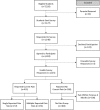Associations between number of pain sites and sleep, sports participation, and quality of life: a cross-sectional survey of 1021 youth from the Midwestern United States
- PMID: 31208385
- PMCID: PMC6572746
- DOI: 10.1186/s12887-019-1576-6
Associations between number of pain sites and sleep, sports participation, and quality of life: a cross-sectional survey of 1021 youth from the Midwestern United States
Abstract
Background: Musculoskeletal pain in youth is common but little is known about the influence of the number of pain sites on pain characteristics. The objective of this study was to compare pain characteristics, quality of life, sleep, sport participation between adolescents without pain, those with single site pain, and those with multi-site pain and investigate the relationship between pain duration and number of pain sites.
Methods: An online survey was sent via email to 7177 possible middle- and high-school students. The students completed a survey containing questions about their pain (including location, duration, intensity, frequency), health-related quality of life, sleep quantity and quality, and sports participation. Quantitative variables were analysed with one-way ANOVAs or t-tests and qualitative variables were analysed with Pearson Chi-squared tests. Relationships were investigated with a Pearson Correlation.
Results: Of the respondents (n = 1021), 52.9% reported no pain, 17.2% reported pain in a single-site, and 29.9% reported pain in multiple sites. Those with multi-site pain reported significantly lower quality of life than both pain-free youth (p < 0.001) and those with single-site pain (p < 0.001); those with single-site pain had lower quality of life than pain-free youth (p < 0.001). Those with pain reported worse sleep than those without pain (P < 0.05). No differences in sport participation were found (p > 0.10). Those with multi-site pain reported greater intensity (p = 0.005) and duration (p < 0.001) than those with single-site pain. A positive, moderate, and significant correlation (r = 0.437, p < 0.001) was found between the pain duration and number of pain sites.
Conclusions: A large percentage of youth experience regular pain that affects their self-reported quality of life and sleep, with greater effects in those with multi-site pain.
Keywords: Adolescents; Children; EQ-5D.
Conflict of interest statement
The authors declare that they have no competing interests.
Figures
References
-
- King S, Chambers CT, Huguet A, MacNevin RC, McGrath PJ, Parker L, et al. The epidemiology of chronic pain in children and adolescents revisited: a systematic review. Pain. 2011;152(12):2729–2738. - PubMed
-
- El-Metwally A, Salminen JJ, Auvinen A, Kautiainen H, Mikkelsson M. Prognosis of non-specific musculoskeletal pain in preadolescents: a prospective 4-year follow-up study till adolescence. Pain. 2004;110(3):550–559. - PubMed
-
- Murray CJ, Richards MA, Newton JN, Fenton KA, Anderson HR, Atkinson C, et al. UK health performance: findings of the global burden of disease study 2010. Lancet. 2013;381(9871):997–1020. - PubMed
-
- Rathleff MS, Rathleff CR, Olesen JL, Rasmussen S, Roos EM. Is knee pain during adolescence a self-limiting condition? Prognosis of patellofemoral pain and other types of knee pain. Am J Sports Med. 2016;44(5):1165–1171. - PubMed
Publication types
MeSH terms
LinkOut - more resources
Full Text Sources



